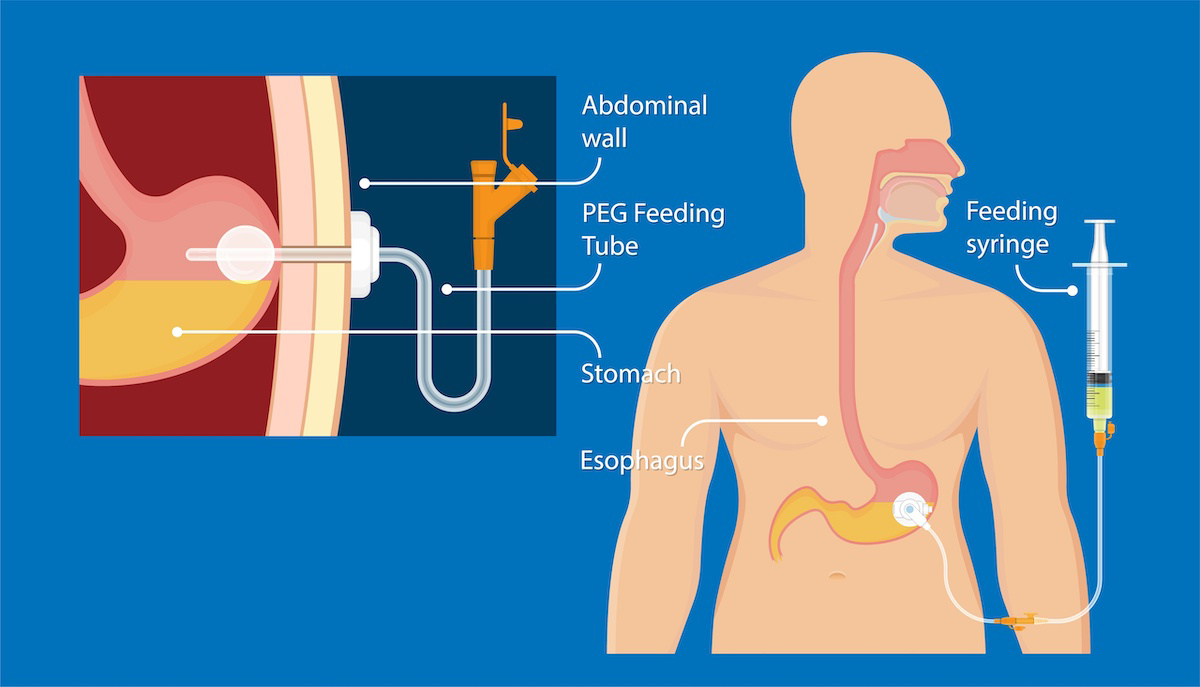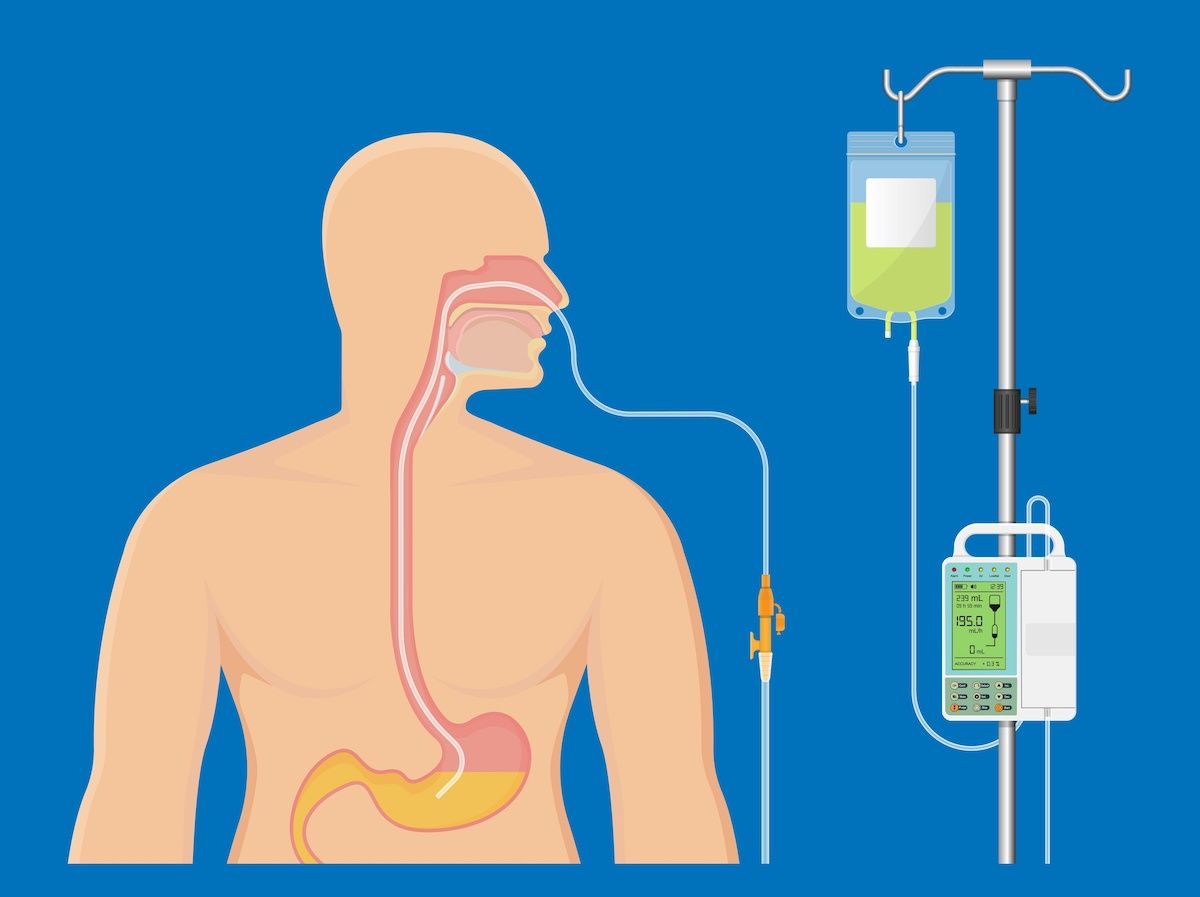Enteral feeding can be an important part of your recovery
Some cancer patients have trouble getting proper nutrition due to an inability to eat, problems swallowing, or surgery to the esophagus, head, neck or stomach. Tube feeding, or enteral feeding, is an effective way to deliver nutrition, fluids and medications directly to the stomach or intestine. In addition, some types of feeding tubes can vent air or drainage, a process called decompression, which may relieve symptoms of bloating and nausea. You might need decompression if you have an intestinal blockage or lack the normal muscle contractions that move food through the intestines.
If you need tube feeding, your doctor will decide which type is best for you based on your medical problem, general health, and how long you will need it.
Naso- (through-the-nose) feeding tubes
For short-term use, a thin, soft tube called a nasogastric (NG) tube can be inserted through the nose and into the stomach. In some cases, the tube can reach a bit further, into the small intestine. When it’s placed into the duodenum, the first section of the small intestine after the stomach, it’s called a nasoduodenal (ND) tube, and if it’s placed in the jejunum, the second section of the small intestine, the tube is called a nasojejunal (NJ) tube. NG tubes also may be used for decompression.
Nasal tubes are very narrow and clog easily, so they must be removed or replaced within a few weeks. Ask your doctor how long your tube will be in place. The answer may be a specific time frame, such as two weeks, or an event, such as when healing is complete.
If you need a feeding tube for a longer time, another type of tube will be placed that goes through the skin on your abdomen directly into your stomach and/or small intestine.
Gastrostomy and PEG tubes
A gastrostomy, or G-tube, is a small, flexible tube that is placed through the abdominal skin into the stomach. One common type of G-tube is the percutaneous endoscopic gastrostomy (PEG) tube. A gastrostomy, G-tube or PEG tube may be used if you:
- Have trouble swallowing or taking in enough nutrition by mouth
- Need decompression
- Have an abnormal narrowing in the esophagus
- Have an abnormal opening (fistula) between the esophagus (food pipe) and the trachea (air pipe)
To place the tube, you’ll likely be given sedation (relaxing) medication and a local anesthetic, to avoid the risks of general anesthesia. The doctor passes a flexible, lighted tube with a camera on the end (endoscope) through the mouth and esophagus and into the stomach to determine the best place to insert the tube. A small cut is made through the skin and abdominal wall, and the tube is placed through the opening into your stomach.
Inside the stomach, the tube is held in place by a balloon inflated with sterile water. On the outside of the stomach, fasteners help hold the stomach up against the abdominal wall. Outside your skin, six to 12 inches of tubing will be visible, with a cap at the end. A plastic disc (flange) holds the tubing close to the skin. After six to eight weeks, you may be able to have your PEG tube changed to a low-profile tube (MIC-KEY tube), which sits at skin level. PEG tubes can last for months or years, but may need to be replaced if the balloon breaks or the tube cracks.
Jejunal feeding tubes
A jejunal or J-tube is a longer, flexible tube that goes through the abdominal skin into your small intestine. Feedings and medications can be given through a J-tube, but not at the same time. Although J-tubes are less common than G-tubes, they are useful when:
- There is an obstruction
- The stomach is absent or isn’t working correctly (doesn’t empty well, or there are other digestive problems)
- Vomiting is chronic
- You are at risk of inhaling or aspirating stomach contents into your lungs
- An abdominal surgery anastomosis (area where organs are reconnected) needs time to heal
Because J-tubes clog easily, continuous feedings are delivered over 12 to 24 hours using a pump. Because the stomach expands easily and the small intestine does not, G-tube feedings can be given faster. You will be taught how and when to flush your tube to prevent clogs.
Gastronomy-Jejunal (G-J) tubes
A G-J tube goes through your skin, into your stomach and into the jejunum. The tube is made up of different sections. The G section is used primarily to vent air or drainage from the stomach, and the J portion is used for feedings. Outside the body, the tube has three access ports: the gastric port to the stomach, the jejunal port to the small intestine, and a third port used to inflate and deflate the balloon that keeps the tube in place.
Never miss another Cancer Talk blog!
Sign up to receive our monthly Cancer Talk e-newsletter.
Sign up!What to know about feedings
If you have a feeding tube through the abdomen placed at Roswell Park, a Registered Dietitian (RDN) will do a full nutrition assessment and review feeding instructions with you. The dietitian can answer questions and address concerns about maintaining hydration and nutrition, but cannot write prescriptions for feeding supplies. Call your clinic for your refills.
- You will be given a demonstration and complete instructions for how to use and care for your feeding tube. Watch our patient education videos on PEG and J-tube care on YouTube.
- A PEG tube does not prevent you from eating or drinking by mouth, but your doctor may limit how much you take by mouth. Expect whatever you are drinking to be seen in your drainage bag when you open it to gravity.
- Keep track of feeding supplies and get a refill at least one week before you will run out.
When to seek help
If your tube falls out, cover the opening with gauze and tape it in place. Call Roswell Park immediately. The tube must be put back in within one to two hours. Do not try to replace it yourself — this must be done by a doctor. If you must go to a hospital closer to you, bring the tube with you, if possible. Call your doctor right away if you have:
- Heavy bleeding, increasing pain, leaking, rash or signs of infection (redness; warmth; swelling; thick, foul-smelling yellow or green drainage; or tenderness) at the tube site, or if your abdomen becomes hard
- Fever of 100.4° F (38° C) for a day or more
- Nausea, gas, bloating, diarrhea or constipation for 24 hours
- Vomiting for more than eight hours
- A clogged tube that you cannot clear
If you need urgent care, our Assessment and Treatment Center (ATC), is open 24/7. You’ll need a referral from your Roswell Park physician or physician on call. Call 716-845-2300 to be evaluated by a triage nurse.
- Bolus feed is a type of tube feeding that delivers a larger amount over a short period of time (less than 30 minutes), similar to having a meal.
- Continuous feed is a type of tube feeding given slowly over a long period of time (hours or overnight), usually using a pump.
- Dumping syndrome occurs when food moves too quickly through the stomach and intestines, causing cramping, nausea and diarrhea.
- Endoscopy is an exam using a lighted, flexible instrument (endoscope) to see inside a part of the body.
- Flush means to run fluid through the feeding tube to prevent clogs.
- Naso- refers to the nose.
- Gastro- refers to stomach.
- Jejunum is the second section of the small intestine.
- Percutaneous means through the skin.
- Stoma is the opening made in your abdomen for the feeding tube.



